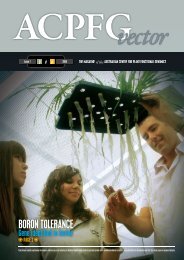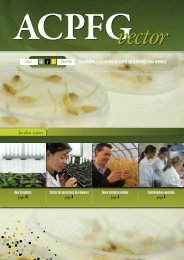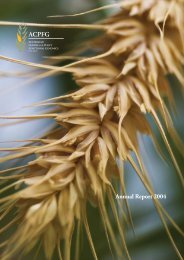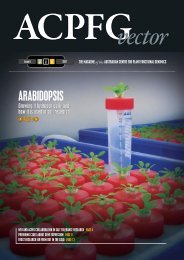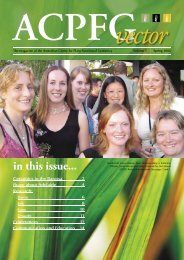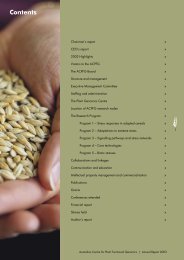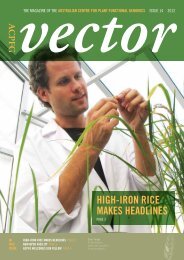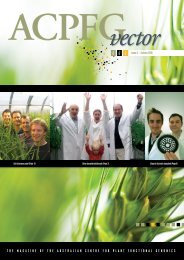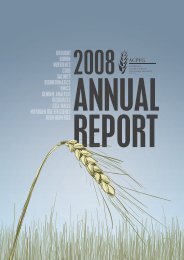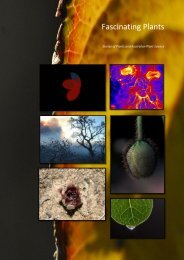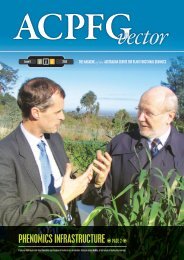ACPFG Annual Report
ACPFG Annual Report
ACPFG Annual Report
Create successful ePaper yourself
Turn your PDF publications into a flip-book with our unique Google optimized e-Paper software.
Cold and Frost<br />
cold and frost<br />
Ulrik John<br />
Ulrik John has broad experience in molecular and cellular biology and in functional<br />
genomics in a range of organisms from yeasts through to fruit flies and wheat. Ulrik<br />
obtained his PhD from the University of Adelaide, and has worked at the Plant<br />
Breeding Institute in Cambridge, UK (now the Cambridge Laboratory at the John<br />
Innes Institute), the Wellcome/Cancer Research Council Institute and the Peter<br />
MacCallum Cancer Institute. His research focus at DPI Victoria, and within <strong>ACPFG</strong>,<br />
is the molecular mechanisms of abiotic stress tolerance in indigenous and Antarctic<br />
grasses with adaptations to extreme environments.<br />
Background<br />
Frost leading to cereal crop damage is a consistent<br />
problem in south-eastern Australia and in Western Australia.<br />
The sporadic nature of frost means it can have a devastating<br />
impact on specific regions, farms or even particular fields<br />
in certain years. Taking into account financial costs from<br />
indirect losses due to delayed sowing, down grading or crop<br />
protection, the total economic impact of frost on wheat and<br />
barley production in Victoria and South Australia is estimated<br />
at $95.8m and $33.6m per annum, respectively. Thus, even<br />
modest increases in cold and frost tolerance in cereals have<br />
the potential to deliver tens of millions of dollars of benefit to<br />
the cropping industries of southern Australia.<br />
Research and activities<br />
The Cold and Frost Program has focused on the isolation<br />
of novel genes and gene variants from barley, Arabidopsis,<br />
and Antarctic hair grass (Deschampsia antarctica). We have<br />
investigated functions of the genes and their promoters and<br />
have defined properties of proteins and cellular metabolites<br />
correlated with cold and frost tolerance. We have also defined<br />
the molecular structure and function of key cold and frost<br />
tolerance conferring proteins and the gene promoters that<br />
drive their expression, and we have used this information to<br />
engineer novel and more efficient variants.<br />
Map based cloning<br />
We are using map based cloning to isolate the gene(s)<br />
controlling reproductive frost tolerance on barley<br />
chromosome 2H. Variation in frost tolerance exists<br />
across barley genotypes, with germplasm of Japanese<br />
origin harbouring significant tolerance to frost damage of<br />
reproductive tissues. This project builds upon earlier work<br />
at the Waite Campus in which a major QTL for reproductive<br />
frost tolerance was mapped. The experimental approach<br />
exploits co-linearity between related regions in the barley<br />
and rice genomes to generate PCR markers close to the Fr-2H<br />
locus. This, in combination with phenotyping, is being used to<br />
define and refine the interval in mapping populations, which<br />
allow segregation of the trait.<br />
Three loci influencing flowering related traits, earliness<br />
per se (eps-3), clystogamy (cly) and rachis internode length<br />
(ril), are clustered close to the putative reproductive frost<br />
tolerance locus on chromosome 2H. In 2007 we have been<br />
investigating whether one or more of these loci can account<br />
for the original ‘frost tolerance’ QTL effect, or whether they<br />
are unrelated to frost tolerance. Additional markers were<br />
developed in the region, extending coverage of markers to<br />
the entire 2H long arm, and additional inversions and breaks<br />
in co-linearity with rice were discovered. We genotyped<br />
recombinants for the 3cM eps-3 interval for: tiller height;<br />
rachis internode length; and time of awn emergence revealing<br />
all of these traits to be essentially co-segregating at the<br />
same locus. Twenty genes are present in the corresponding<br />
rice interval, one of which has a barley orthologue that is a<br />
credible co-segregating candidate for the controlling gene.<br />
We are isolating and defining the functions of candidate cold<br />
and freezing tolerance conferring genes from Deschampsia<br />
antarctica (the only grass species native to Antarctica) and<br />
assessing their potential to enhance tolerance in sensitive<br />
species. A gene discovery and functional genomics program<br />
in D. antarctica has produced 10,704 high quality ESTs,<br />
representing 4,811 non-redundant unigenes. We will test the<br />
phenotypic consequences of gain-of-function expression of<br />
candidate genes, including those encoding variants of ice<br />
26 2007 <strong>ACPFG</strong> ANNUAL REPORT



